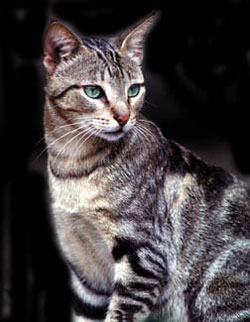Sokoke Cat
Category: Cats

Facts about Sokoke Cat, "Scientific name for cat Felis Catus". The "Sokoke Cat" have a unique pattern and coat color. The Sokoke Cat have an interactive behavior which makes them to be considered as domestic breed. However, the Sokoke Cats are naturally occurring native breeds which have evolved on their own without any intervention from humans.
A Sokoke Cats jaw can not move sideways, there for a cat can not chew large pieces of food. A Sokoke Cats back is highly flexible because of its 53 loosely fitting vertebrae. The body of a cat has 230 bones. While a human body has 206. Compared to a humans who only have 34. The Sokoke Cat breeds were first discovered in Kenya by the Giriama people. They gave it the name Khadzonzo which means, come pretty one
Cats outer ear uses 32 muscles to control it, and a human has only 6 muscles in its ear and a Sokoke Cat can move its ears 180 degrees. A Sokoke Cat can move their ears independently.
Sokoke Cats on average sleep 13 to 14 hours a day and when they are awake, the spend a lot of time licking themselves to keep themselves clean. Sokoke Cats help control rodents like small rats and mice where the live farm homes, warehouse their houses ect. The Sokoke Cats have thin, slightly hard-textured coats with very little coats underneath. The Sokoke Cat are upright short haired breeds which are known for their beauty.
The Sokoke Cat breed are considered to be medium sized, athletic, lithe and with a muscular body. The male Sokoke Cat breeds tend to have a hard body with thin, stiff-feeling, hard tail. The Sokoke Cat bodies usually have a rigid feel when they are crouching or standing. However, when the Sokoke Cat are more relaxed, they are amenable to holding and carrying. The female breeds are smaller than the males and have fine bones.
There are two types of Sokoke Cats. There are those Sokoke Cats with a slightly deeper, thicker and a rounder face while there are others having oriental looking posture with a longer face and a slender leggier body.
The Sokoke Cats have an elegant, consistent air about them which makes people become attracted to them at their first site. The Sokoke Cat unique ticked pattern coats together with ground coloring give them an appealing look which can be so eye-catchy.
The Sokoke Cats are best described as intelligent, sensitive, intuitive territorial and loving. The Sokoke Cat are friendly to humans as they prefer a seat at the back of couch or drop to the feet of their favorite person in the family as a sign of greeting. The Sokoke Cat loves to perch near windows and can produce alarming calls when they sense any danger. The Sokoke Cats are considered to bond fiercely with humans and are very entertaining.
The Sokoke Cats are easy to care for. The Sokoke Cats are considered to be in door cats as they can be prone to various diseases when exposed to the outside environment. The Sokoke Cat coats require to be brushed at least twice a week to remove tangle and dead hair.
Sokoke Cat Facts
There are over 500 million domestic cats in the world and 88 million in the United States Approximately 40,000 people are bitten by cats in the U.S. annually. A female cat is called a "queen or molly", male cat is called a "tom" and the name "clowder" is called a group and young or baby cats are called kittens. Domestic cats have an average weight around 8.7 to 11 pounds (3.9 to 5 kg). Sokoke Cats have very sharp hearing and their sense of smell is fantastic. Sokoke Cats average life span is around 12 to 15 years.
The reason why Sokoke Cats can squeeze through very small spaces is that they have no collarbone and free-floating clavicle bones that their shoulders are attach to their forelimbs, that's why a Sokoke Cat can fit through a hole the same size as its head and they use their whiskers to determine if they can fit through the space.
Sokoke Cats can see at levels of light six time lower than a human, this is why Sokoke Cats can catch mice so easily at night. The cat's hairball is called a "bezoar" (meaning a concretion or calculus found in the intestines or stomach of certain animals, in particular ruminants, formerly alleged to be an effective cure for poison). A Sokoke Cat can climb up a tree well but can not climb head first down a tree, because all the claws on a cat’s paw points the same direction, to get down from a tree, a Sokoke Cat has to back down.
A Sokoke Cat can run at a top speed of about 30 mph (48.2 km) over a short distance. A Sokoke Cat rubs against a person to not only to be affectionate but also to mark out its territory. A Sokoke Cat does not like water because its fur is not insulate it well when it gets wet. A Sokoke Cat averages about 12 whiskers on both side of its face.
The average Sokoke Cat temperature of a cat is 101.5 °F. The Sokoke Cats heart beats at 110 to 140 a minute, That is almost twice as fast as a human heart. A Sokoke Cats has 30 teeth while a kittens has about 26 teeth that they will lose at about 6 months of age. A Sokoke Cat has the ability to jump up to six times its length. The fear of cats "Ailurophobia".

 Back To Category Cats
Back To Category Cats